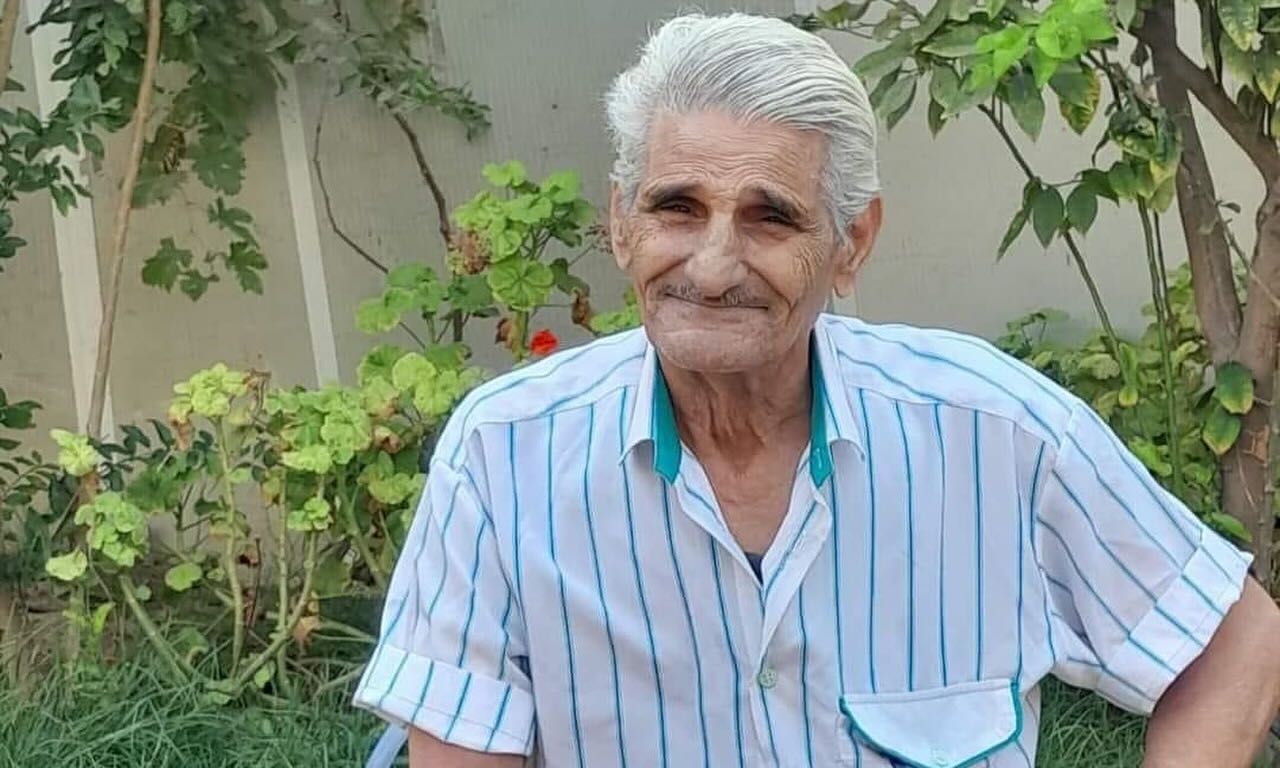Fathi Ghaben was frequently hailed as the Van Gogh of Gaz
Fathi Ghaben Photo: Sliman Mansour via Facebook
The renowned Palestinian artist Fathi Ghaben has died in Gaza after his appeals to leave the war-torn exclave for urgent medical treatment were left unanswered by Israeli authorities.
Frequently hailed as the Van Gogh of Gaza, Ghaben reportedly grappled with chest and lung issues—exasperated by smoke from the recent bombardments—for which he was unable to find treatment in Gaza’s shattered healthcare system.
Despite numerous appeals from his supporters and family, his requests to leave the exclave for urgent medical treatment received no response; he died on 25 February in Gaza at the age of 77.
In an emotional video uploaded to Facebook on 19 February by a relative in a desperate attempt to raise awareness about the urgency of Ghaben’s case to leave Gaza, the frail artist can be seen coughing violently and struggling to breathe. He interrupts the plea to tell the camera, “I am suffocating. I want to breathe, I want to breathe…,” a phrase that he repeats again and again until speaking becomes too difficult and he has to be physically assisted while the camera moves off him.
In a statement, the Palestinian ministry of culture said that Ghaban needed to travel abroad “to complete his treatment, due to the lack of medicine and oxygen in Gaza, but the occupation authorities did not allow him to leave the Strip.”
“Ghaben’s departure constitutes a loss to Palestinian art,” the ministry said.
The self-taught artist, who had been imprisoned by the Israeli authorities on a number of occasions, was a symbol of resistance and resilience in Palestine’s cultural scene.
Born in 1947 in the village of Harbia, north of Gaza, he and his family were among hundreds of thousands of Palestinians who were forced to leave their homes during the Nakba, the Arabic term that refers to the 1948 mass displacement and dispossession of Palestinians after the creation of the state of Israel. He left school when he was a teenager to sell newspapers to support his family but eventually became a full-time painter.
In a bold act of early resistance during the early 1980s, a period when Israel strictly prohibited the painting of the Palestinian flag or even the use of its colours, Ghaben defied these bans, portraying the Palestinian people's plight and their flag in his work. His painting Identity, for example, depicts a farmer with a long neck standing defiantly in front of Al Aqsa Mosque in Jerusalem, carrying the lifeless body of a woman. The colours of the figure's clothing and the horse's mane represent the Palestinian flag. Thousands of posters of his colourful art spread around Gaza and the West Bank. His rebellion led to a six-month prison sentence in Israel in 1984.
“He was the first to use the Palestinian flag in paintings…I vividly remember posters of his art everywhere in the city,” Aser El Saqqa, the Palestinian-born founder and managing director of Arts Canteen, a London-based arts organisation that supports artists from the Arab world and beyond, tells The Art Newspaper. “For us to see the Palestinian flag at that time was a sign of encouragement and bravery. I really don’t know how he managed to get so many posters printed,” he says.
El Saqqa’s first encounter with Ghaben was in the early 1980s when he was commissioned to carry out some work for a private school run by El Saqqa’s father.
In the absence of cinema and photography at the time, El Saqqa says Ghaban’s work allowed people to see the Palestinian way of life and culture though his colourful paintings, showing women in their traditional Palestinian clothes and farmers hard at work. Ghaben’s work also carried themes of protest, aimed to inspire people to resist occupation and injustice.
Although their encounters were short-lived and the two fell out of touch over the years, El Saqqa says he continued to follow Ghaban’s work from afar. “All of the artists I work with are really influenced by Fathi,” El Saqqa says. “Not necessarily by his cool artistic school of thought but by his character, his charisma, his narrative, his solid position in defending the Palestinian rights, by all the stories he documented and painted beautifully,” he adds.
Ghaben was an influential figure in starting Gaza’s art movements. He was one of the founders of the Association of Fine Artists and Artists in Gaza in addition to his own centre, Fathi Ghaben Centre for the Arts. He also served as an adviser to the ministry of culture. In an Arabic TV interview, his distraught wife said the family was displaced after his house—along with his paintings—was bombed and destroyed.
Several events have been held in the artist's memory, including an event organised by the staff, students and alumni of the University of the Arts London (ULA) on 26 February titled "Solidarity with Artists in Gaza" where El Saqqa spoke about Ghaben and his legacy.
Since his death, social media accounts and Ghaben’s Facebook page have been flooded with messages from fellow artists and cultural figures, including pictures of students and family members who visited the artist in hospital.
In a January report the ministry of culture noted the death of 41 cultural figures in Gaza who had played a significant role in literary and artistic forums. The Gaza health ministry says it has recorded more than 30,000 deaths and over 70,000 injuries in the past five months, following Hamas’s 7 October terrorist attacks in Israel in which around 1,200 people reportedly died and 253 people were taken hostage.

